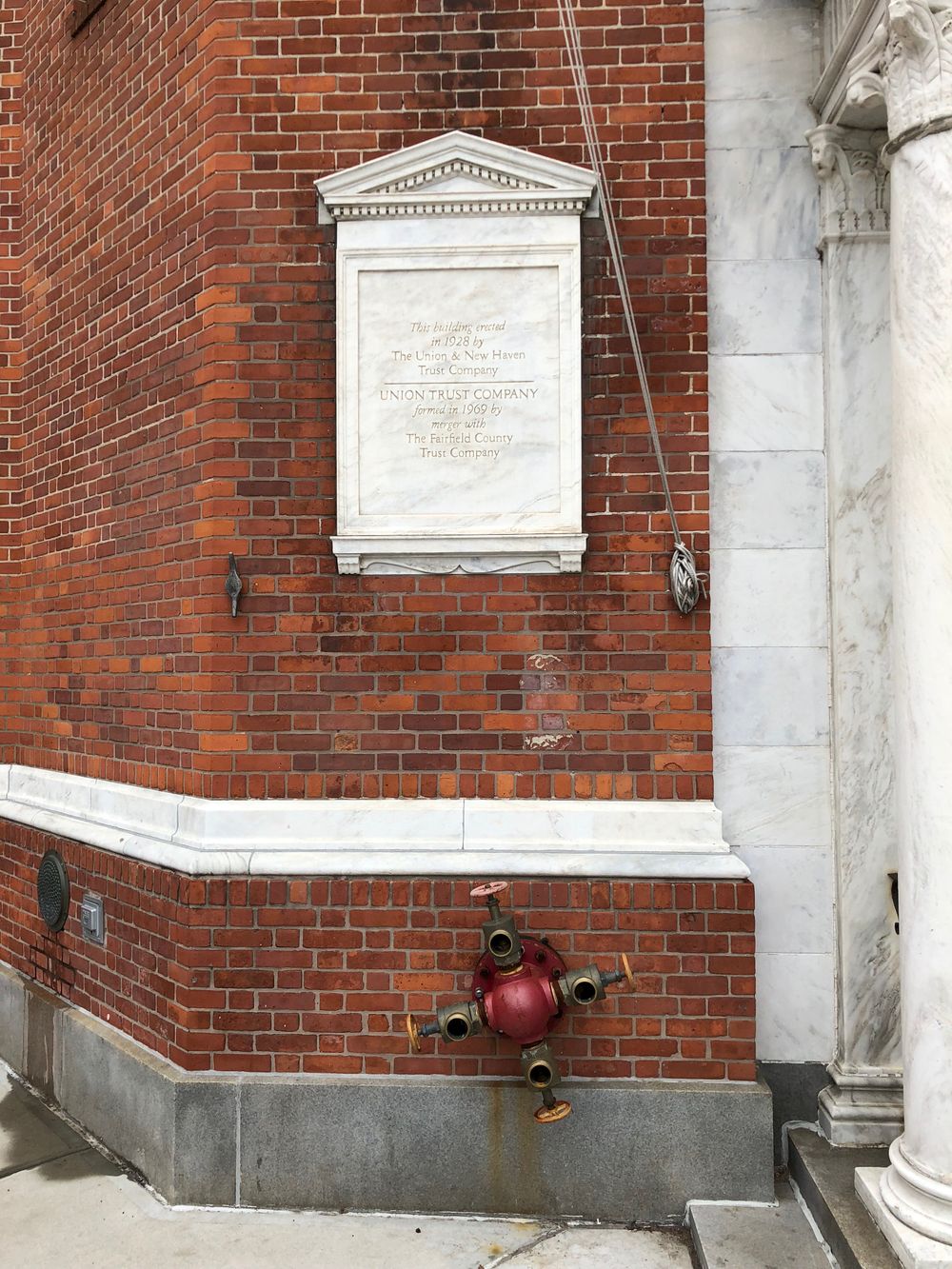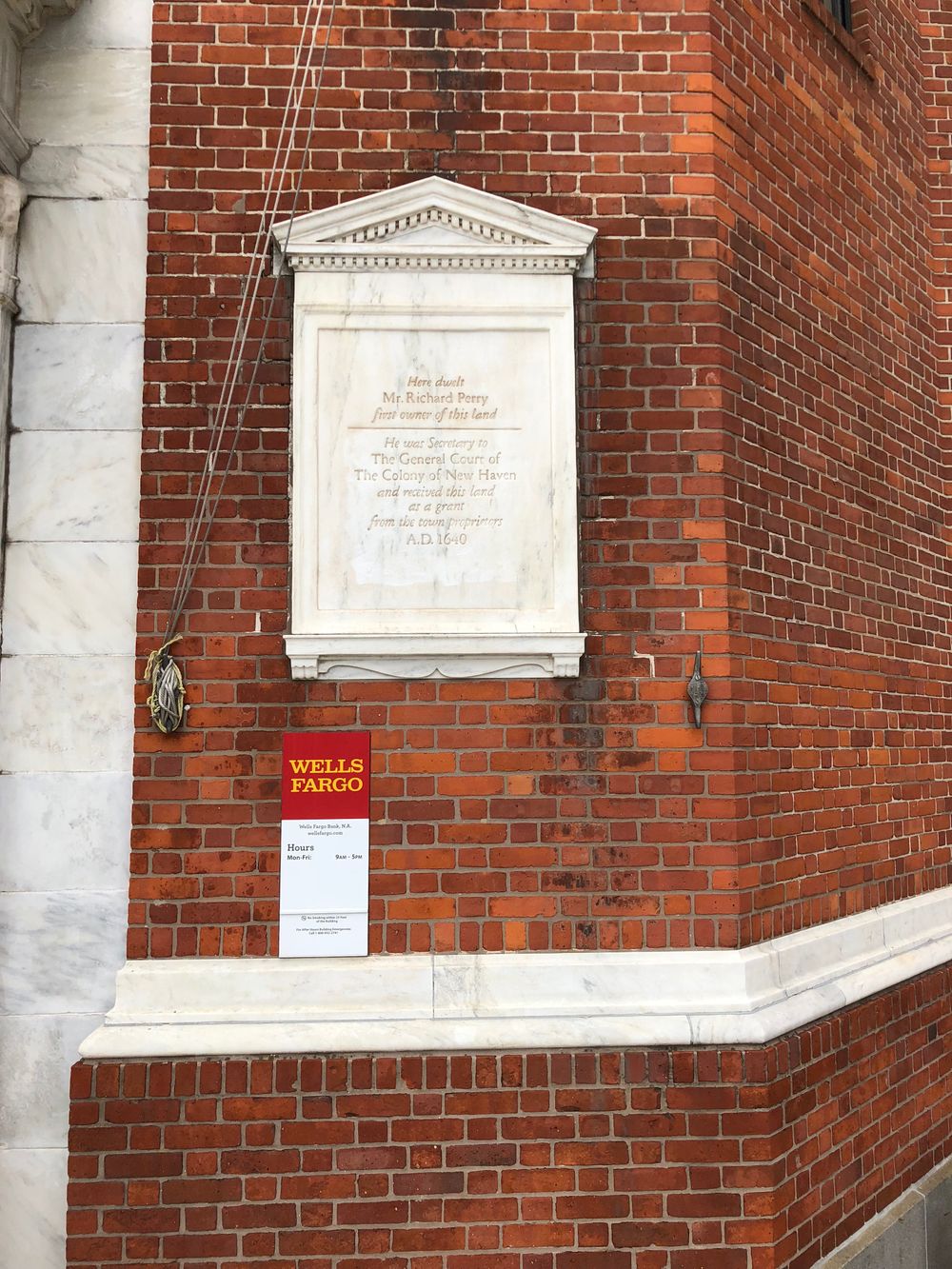
Union and New Haven Trust Building
205 Church Street, New Haven, CT
Built in 1927, the Union and New Haven Trust Building is a paragon of the Colonial Revival style that was a central aspect of 1920s architecture in New Haven. For most of its history, it was an office building with a bank on the ground floor, but in 2014, the offices were converted to apartments, and the building was renamed The Union. A bank still occupies the ground floor, but now it is Wells Fargo instead of the Union and New Haven Trust Company. The Union and New Haven Trust Building was a central component of the consolidation of New Haven’s modern office district downtown and remains a stately emblem of the Colonial Revival style of the Roaring Twenties.
Hampshire New Haven (sold 05/15/2009)
205 Church St. LLC (sold 11/17/2006)
Independence Realty (sold 09/01/1989)
The Union and New Haven Trust Company building was designed by architects Cross & Cross. It was constructed in 1927 on the site of the Security Insurance Co. building (2). The builder was Ridgeley Larkin, president of the Larkin-Carey Real Estate Company (10).
In 1969, the Union and New Haven Trust Company became the Union Trust Company in a merger with the Fairfield County Trust Company (this is engraved on a marble plaque on the building’s facade). In 1981, the Union Trust Company relocated its headquarters to Stamford, CT, but kept a branch office on the ground floor of the New Haven location (11). Twelve years later, First Fidelity Bancorporation Inc. and Banco Santander, S.A. acquired Northeast Bancorp, Inc., of which Union Trust Company was a subsidiary (12). Although it changed owners several times, it seems that the building housed a bank and offices continuously until May 2009, when it was sold to Hampshire New Haven (2). Hampshire supposedly evicted the “random collection” of lawyers and businesspeople who had rented the offices (13), and proceeded to refurbish the exterior and interior, attempting to keep the building true to its historic style and to make it more environmentally sustainable (14). Some of the improvements included restoring the cupola, the facade, and the marble railing around the 11th story (14). There was speculation that these new owners were planning to convert part of the building from offices to a luxury hotel (14). By 2013, however, the plans to turn the building into a hotel had still not been accomplished (13). In March of that year, the building was purchased by Cooper Church LLC (15) and ultimately converted into an apartment building, which was renamed The Union. The building is still home to a bank, currently Wells Fargo.
The New Haven Green and surrounding buildings looked like a typical New England town until around the time of World War I, with the emergence of the Taft Hotel, the library, post office, and courthouse, all of which contributed to a more modern, urban style (3). Around the same time, however, there was a strong pull to return New Haven to its traditional appearance, which led to the Colonial Revival era of the 1920s, which the Union and New Haven Trust Building magnificently exemplified. When the building was completed in 1928, the Roaring Twenties had yet to see their demise: The stock market would crash in October of the following year (4). Another paradigm of this style was the New Haven Colony Historical Society on Whitney Avenue, built 1929, which even featured a cupola like the Union building (1). Yale was in the process of building several new residential colleges, including Pierson College, also Colonial Revival, in 1930 (5). In 1928 New Haven’s banks and business leaders founded a philanthropic organization, the Community Foundation of Greater New Haven, which still exists today (6). In May 1929, across the street from the new building, the city erected the World War Memorial and Flagstaff on the New Haven Green, near the place where the first Liberty Pole stood before the American Revolution (6). In doing so, they tied the city’s memory of World War I to its revolutionary spirit. Perhaps Colonial Revivalism was a visual manifestation of a deeper undercurrent of nationalism, which was prevalent in many city institutions. New Haven in the 1920s had a large immigrant population, and as in many American cities at the time, there was a drive to “Americanize” the newcomers, especially through assimilation in schools, where children supposedly came to love “the stars and stripes” (7). This nationalistic spirit may have contributed to the return to Colonial architecture.
Meanwhile, the popularity of the chain store, “with its ‘cut prices,’ standardized merchandise, clever advertising, and uniform, impersonal service,” was dramatically reshaping downtown New Haven (8). On Chapel and Church Streets in the ’20s, where the construction of the Union building was imminent, national chains were rapidly replacing local shops (8). By 1930, chain grocery stores, drugstores, cigar stores, ice cream parlors, hardware stores, and more dominated the area, causing a full-fledged “commercial revolution” (8).
When the Union and New Haven Trust Building was converted into an apartment complex named The Union in 2014, Mayor Toni Harp said, “We are delighted to see how there’s new life in this cornerstone property, and we treasure what it means beyond all work that has been done here. We recognize how this investment in New Haven signals progress for New Haven. We know the confidence these owners and developers place in New Haven’s future helps to decide New Haven’s future. We’re grateful for their confidence and we’ll keep working every day to earn it all over again” (9).
The Union and New Haven Trust Building is located on the corner of Church and Elm Streets, where there are nearly always pedestrians gathered on the sidewalk, gazing across at the Green while waiting to cross the busy intersection. The building’s facade, now the entrance to Wells Fargo, has been constructed on the street corner such that the building faces the New Haven Green diagonally (2), giving it a strong presence at the edge of this urban hub. The building is located downtown, in the midst of a bustling commercial area with high building density (2). It is surrounded by government buildings, offices, and banks. In addition to the Wells Fargo that shares building, there is Citizens Bank, KeyBank, New Alliance Bank, the law firm Harris Beach, and New Haven City Hall. Behind the Union and New Haven Trust Building is the 59 Elm Street parking lot.
The Union and New Haven Trust Building is a 13-story brick building of the Colonial Revival style (1). The exterior is in excellent condition due to recent restoration work. The narrow facade of the building, set on the street corner (2), soars several stories above the broader lateral faces and culminates with a cupola, reflecting the one that tops the United Church, located across from the Union on the New Haven Green (1). Although the building is immense, architects Cross & Cross incorporated design elements to honor New Haven’s Federal Green, describing it as a tower “of pure Colonial design” that possessed “refinements of appropriateness” (1). The Colonial Revival design is in harmony with the library of the same style on the north side of the Green (2). The Union’s cupola is topped by a golden dome, which is illuminated red at night, and is an icon of the Elm City’s lively and historic downtown.
- Elizabeth Mills Brown, New Haven: A Guide to Architecture and Urban Design (New Haven, CT: Yale University, 1976), 114.
- Historic Resources Inventory document, c.o. New Haven Preservation Trust
- Brown, New Haven, 104.
- Rollin G. Osterweis, "The Fabulous Twenties," in Three Centuries of New Haven, 4th ed. (Dexter, MI: Yale University Press, 1975), 420.
- Brown, New Haven, 72.
- Robert J. Leeney, New Haven in the Twentieth Century (Montgomery, AL: Community Communications, 2000), 39.
- Ibid., 35.
- Osterweis, “The Fabulous,” 416.
- Markeshia Ricks, "Downtown Rent Tops $6K," New Haven Independent (New Haven, CT), July 20, 2016, accessed February 25, 2018, http://www.newhavenindependent.org/index.php/archives/entry/uinon_trust_opening/.
- Everett Gleason Hill, A Modern History of New Haven and Eastern New Haven County (New York: S. J. Clarke, 1918), 2:543.
- "Union and New Haven Trust Building (1927)," Historic Buildings of Connecticut, last modified October 18, 2012, accessed February 24, 2018, http://historicbuildingsct.com/?p=12975.
- State of Connecticut, "DOB: Bank Mergers/Acquisitions 1990-1999," Connecticut
- Department of Banking, last modified May 7, 2010, accessed February 25, 2018, https://web.archive.org/web/20141112203841/http://www.ct.gov/dob/cwp/view.asp? a=2228&q=296978.
- Paul Bass, "So Long Hotel; Hello Apartments," New Haven Independent (New Haven, CT), April 18, 2013, accessed February 25, 2018, http:// www.newhavenindependent.org/index.php/archives/entry/ so_long_hotel_hello_apartments/.
- Mary O'Leary, "Union Trust Building Conversion Sought," New Haven Register (New Haven, CT), December 9, 2009, accessed February 25, 2018, https://www.nhregister.com/news/article/Union-Trust-Building-conversion- sought-11639763.php.
- City of New Haven Online Assessment Database, http://gis.vgsi.com/newhavenct/ Parcel.aspx?pid=13858.
Researcher
Madeleine Stern
Date Researched
Entry Created
February 25, 2018 at 1:45 PM EST
Last Updated
July 26, 2018 at 2:38 AM EST by null
Historic Name
Style
Colonial RevivalCurrent Use
ResidentialBankEra
1910-1950Neighborhood
OtherTours
Year Built
1927
Architect
Cross & Cross
Current Tenant
Roof Types
FlatStructural Conditions
Very Good
Street Visibilities
Yes
Threats
None knownExternal Conditions
Very Good
Dimensions
106' x 165'
Street Visibilities
Yes
Owner
Cooper Church LLC
Ownernishp Type
Client
Historic Uses
CommercialBanking
.jpg)








Comments
You are not logged in! Please log in to comment.